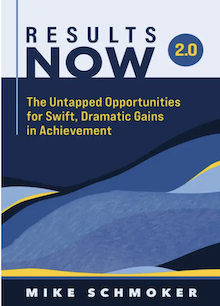Opportunities for Swift Achievement Gains
Results Now 2.0: The Untapped Opportunities for Swift, Dramatic Gains in Achievement
By Mike Schmoker
(ASCD, 2023 – Learn more)
Reviewed by Cathy Gassenheimer

“A book that fearlessly turns over the rock to expose what isn’t working in schools today – the whims, fads, opportunism, and ideology that run rampant. Schmoker is angry – we know what to do, but we do anything but – and he offers excellent ways out of this smog and delusion.”

Results Now 2.0 builds on Schmoker’s original book, Results Now, and the reader will notice that many of the references are dated. Sadly, even some of the quotes from the late 1990s still ring true. For example, the late Richard Elmore noted in 1999, “Effective practice is voluntary and therefore rare” (p. 17).
Visit any school and chances are you’ll find classrooms where teachers and children are thriving and learning together at high levels. Then walk to the classroom next door and you may see students sitting in straight rows completing low-level worksheets or a computer-generated task.
Let me give a disclaimer at the front end of this book review: I don’t enjoy criticizing schools and try to always focus on the positive. Yet, as Schmoker points out, for schools and districts to improve, they must “confront the brutal facts” and address those areas in which they are falling short.
How to Read the Book
This may be a book that you want to read in parts and pieces. The publisher, ASCD, provides a link to the first chapter of the book that you can access here. In that chapter Schmoker offers a good overview of what’s to come.
Next, spend some time reviewing the Table of Contents. In addition to a preface and brief introduction, the book is organized into eight chapters:
Chapter 1: The Buffer: The Brutal Facts of K-12 Education
Chapter 2: Curriculum: The Foundation of Effective Education
Chapter 3: Literacy: The Engine of Equity
Chapter 4: Effective Instruction: A Remarkable Convergence
Chapter 5: When Evidence Goes AWOL
Chapter 6: The (Mis)Education of Educators
Chapter 7: Why Professional Development ‘Almost Always Sucks’
Chapter 8: How We Can Get Results—Now
Pick a chapter that jumps out at you and start there. You’ll note that each chapter ends with a brief set of questions serving as a “how-to” section for school leaders. For example, Chapter 4, Effective Instruction: A Remarkable Convergence, offers these questions (p. 98):
►Do instructional coaches, providers of professional development, and professional learning community teams make every teacher’s mastery of explicit, structured instruction one of their highest priorities?
►Does professional development, including faculty meetings, regularly feature the modeling of short but instructive segments of effective teaching by instructional coaches, teachers, or administrators?
►Have leaders conducted an instructional audit to determine if students:
- Are employing the basic elements of structured instruction most of the time as a prerequisite to more independent learning or projects?
- Are not spending excessive time in groups doing work of questionable value?
- Are not completing low-level worksheets?
►Do teachers frequently cold-call students to ensure that all students are attentive?
►Have teachers been taught to cold-call in a way that prepares students to respond when called on (for example, by giving them opportunities beforehand to read, study, or prepare a response to questions or problems, sometimes after having a chance to discuss responses with a partner?)
What’s Structured Teaching?
Schmoker calls upon Doug Fisher and Nancy Frey to explain structured teaching. Basically, the two prolific authors explain it as explicit and scaffolded instruction, beginning with sharing the learning target(s) with students and making sure it is understood by all students. The learning target is linked to success criteria (e.g., a clear statement about what they are supposed to learn). “Example: I will be able to write a coherent paragraph to support a claim with textual evidence” p. 81).
The next step in structured teaching involves explicit instruction with the teacher explaining or modeling the learning in “manageable steps or chunks at a reasonably brisk pace” (p. 81). Students then are given time to work individually or in groups to discuss and deepen their learning, which allows the teacher to visit each group to check for understanding. The final step is reteaching, if needed, using what the teacher has gathered through their formative assessment(s).
Getting Results Now
The final chapter recaps the steps and practices Schmoker believes are necessary to ensure effective teaching and learning in every classroom. I wish I had read this chapter after the introduction as it provides a solid pathway to success. The steps closely correspond to the table of contents and begin with confronting his difficult facts by a deep dive into both quantitative and qualitative data. Additional steps include using the data gathered to:
►Conduct instructional and curriculum audits;
►Focus professional development on insights from the audits;
►Have PLCs equip teams of teachers to “develop and continuously refine high-quality, literacy-rich curriculum with appropriate central office guidance; master the core elements of effective teaching and employ them consistently; [and] collaboratively build and refine lessons and units together on the basis of assessment results” (p. 164);
►Strengthen the school culture to recognize both individual and group accomplishments;
►Share measurable results;
►Develop effective curricula; and
►Share progress with key stakeholders.
Retooling University-Based Teacher and Leader Preparation Programs
Schmoker reserves much of his vitriol for teacher and leader education programs. In the chapter titled “The (Mis)education of Educators,” he quotes former head of the National Center on Education and the Economy Mark Tucker, who notes higher education “is the weakest link” in K-12 education.
Schmoker then adds his own two cents: “The problem with our education schools, as any teacher will tell you, is that practical training, with mastery of its goals, is precisely what is absent from their programs. Teacher education, he argues, should emulate medical training, “a profession where practitioners learn their practice through practice” (p. 140).
Take a Deep Breath…
Reading this book is both difficult and challenging. It will force you to confront some uncomfortable truths. But don’t stop there. Spend some time with the last chapter, “How We Can Get Results—Now” and consider Mike Schmoker’s steps.
The book ends on a hopeful note: If schools and districts follow his proposed steps, he says, “we could truly enter a golden age of education…If we want it bad enough” (p. 169).
Cathy Gassenheimer is a professional learning consultant specializing in collaborative adult learning and collective efficacy. For 22 years she was Executive Vice President of the Alabama Best Practices Center, a program of Alabama’s statewide nonprofit A+ Education Partnership, and led the work of three statewide educator networks focused on teaching, leadership, and instructional coaching. Connect with her via LinkedIn and on Twitter @cathygassenheim.




































